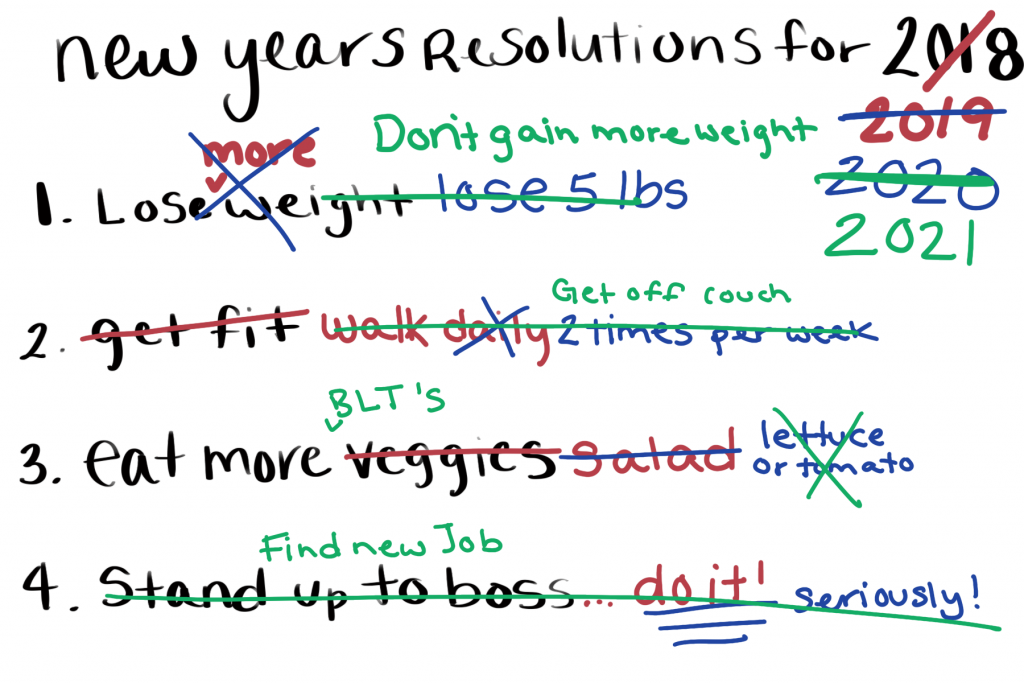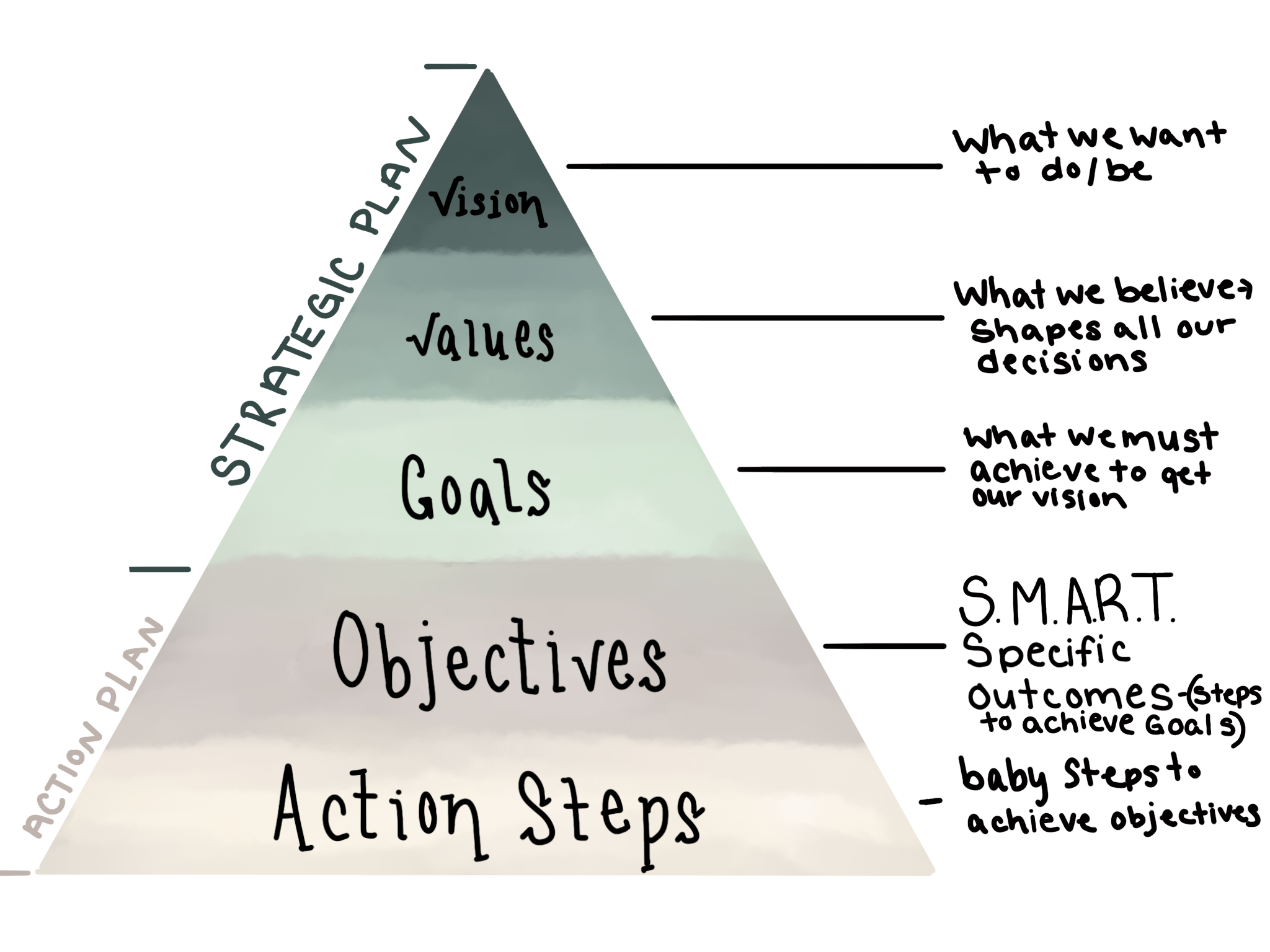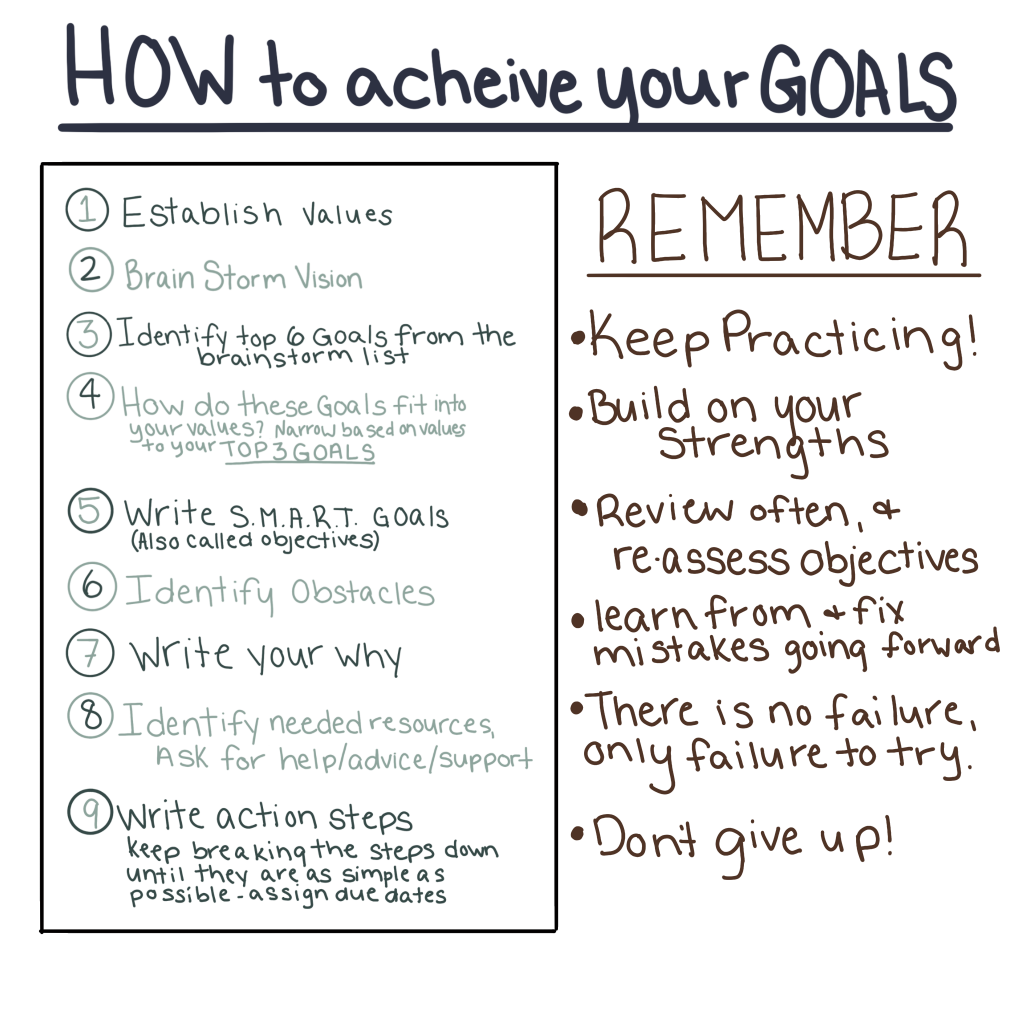How To Set Goals You Can Actually Achieve
Say “no” to new year’s resolutions and learn how to set effective goals, objectives, and action steps that actually set you up to succeed.
This is part one in a series on goal setting. Be sure to check out part 2 here
Every year we hear all about New Year’s resolutions or maybe you call them goals… but isn’t this pretty much how they go? Year after year we set resolutions- which are essentially wishes- or goals with zero plan for how we will succeed. And somehow we think we will magically be able to achieve these half wish goals next year?

It isn’t surprising that we embrace the desire for change as a new year rolls around. The new year naturally feels like a chance for a fresh start. It leaves people feeling hopeful about the coming year and forces them to reflect over the past year.
But setting resolutions is a big mistake- research shows that 80% of new year’s resolutions fail by february. So this year try setting goals in a way that actually sets you up for success!
1. Goals -vs- Objectives
Let’s start by identifying what a goal is not. It is NOT a wish, dream, vision, mission, or resolution. It does however explain what you want to achieve and it is informed by your vision and values.
Objectives are actionable steps that help you achieve your goals. Think of it like this: Vision & Values -> Goals -> Objectives -> Action steps
This chart may help explain the difference between Goals and Objectives.
| GOALS | OBJECTIVES | |
|---|---|---|
| DEFINITION | general guidelines that explain what you want to achieve in your life | define strategies or implementation steps to attain the identified goals |
| PRINCIPLE | based on ideas | based on fact |
| PLAN | broad in scope | narrow in scope |
| SIZE | large in size, the whole | small chunks, part of the whole |
| EXAMPLE | be debt free by 2022 | save money by eating out less than 3 times per month |
| ACTIONS | a general outcome | specific outcome with measurable action steps- supports the attainment of the goal |
| MEASUREMENT | difficult; goals are usually intangible and may not be strictly measurable | easy; it must be measurable and tangible |
| TIMEFRAME | long-term | medium to short-term |
2. Write your SMART objectives and action steps
SMART stands for Specific, Measurable, Action-oriented, Realistic, and Time-bound. This term is often used for goals, but in reality SMART goals are simply well written objectives.
When you write your goals start with the strategic plan (vision, values, goals) and then move onto your action plan (objectives, action steps). Consider the pyramid below: When writing your goals start at the top and move down the pyramid. You may end up with many objectives and even more action steps for each goal.

Example:
- VISION: I want to be excellent in my field of work and be highly respected.
- VALUE: I have identified Excellence as my main value in the work/career portion of my life
- GOAL: I will get a doctorate degree in my field of work
- OBJECTIVE 1: I am done with my thesis
- ACTION STEP 1: Gather research data
- Break it down further- how to gather research data
- baby steps to do this
- more baby steps
- more baby steps
- ACTION STEP 2: Another step
- Break it down further
- ACTION STEP 1: Gather research data
- OBJECTIVE 2: I graduate on May 30, 2022
- ACTION STEP 1
- Break it down further
- ACTION STEP 1
- OBJECTIVE 1: I am done with my thesis
- GOAL: I will get a doctorate degree in my field of work
- VALUE: I have identified Excellence as my main value in the work/career portion of my life
Finally- go back in and add due dates for each action step and objective!
3. Write your Goals and Objectives in the POSITIVE
We tend to get what we focus on. Whenever we say “I want to stop biting my fingernails” our brain has to first build a picture of what you DON’T want- bitten fingernails- in order to not do it. Try NOT thinking of an alligator biting your toe… I bet that is all you can think about now?
THIS:
- I have healthy fingernails
- I weight 150 lbs
- I have $5000 in savings
NOT THAT:
- I want to stop biting my nails
- I want to lose 20 lbs
- I want to stop spending
4. Write your Goals and Objectives in the PRESENT TENSE
Stating your goals in the present tense helps your brain assume you will be successful. For example: “On September 30th I have healthy fingernails.” or “On June 1st I have a new job.” or “On October 15th I am running an 8 minute mile.”
5. Consider your personal Values and Vision
Your vision is what you want to do or be, but your values are what you believe. Your values shape all your decisions. If you are unsure what you want or what you value, it’s impossible to have direction. When you have no direction, you end up going wherever life takes you. Knowing your vision and values allows you to stay focused, say “no” when needed, and prioritize the important stuff.
Setting goals that don’t line up with your values is like swimming upstream. It may not be impossible, but it certainly doesn’t set you up for success. Personal values could be family, adventure, security, independence, wisdom, joyfulness, tradition, tolerance, ect. Our goal setting workbook includes an exercise that can help you identify your top values, how they fit into your wheel of life, and how to pick goals that improve your life based upon your values.
6. Know your why…
It is important to identify WHY you want this goal. Try an exercise where you ask yourself 5 times why- keep answering and follow up with why until you can’t break it down further. After 5 or so times you will end up with the true reason why.
Consider the following questions as you plan your goals:
- How will achieving this goal make me feel?
- How will achieving this goal benefit me?
- How will I feel if I don’t achieve this goal?
- What is the pain point- what will happen if I don’t achieve this goal?
- What obstacles will I face? How can I overcome them?
- What do I need to do, be, or have to achieve this goal?
- Who will be my accountability, support, or cheerleader?
7. Review and adjust often
Be prepared to make mistakes. Nobody expects you to be perfect… just keep trying. It’s only failure if you fail to try. Keep practicing and learn from your mistakes going forward. Remember that practice makes progress- not perfection. So, give yourself a little grace and don’t quit just because you made a mistake or missed a deadline. Adjust and keep going.
8. Grab our goal planning workbook or our digital planner to help you with your goal planning in 2021
-use the code 5BJWCDVM for 21% off all digital items through January 7th!
We have created some really amazing resources for you to help you achieve your 2021 goals! Our 15 page goal planning workbook is a digital pdf that you can print and use over and over. It will walk you through all the steps of goal planning.

Our new ultimate digital planner works on any tablet (requires certain apps and recommended for use with stylus). The planner includes all the budget worksheets and the goal planning workbook, plus has goal planning built directly into your monthly, weekly, or daily pages!
And a quick visual guide for you:

Do you need help setting your goals and accountability to achieve them?
Have you ever thought about talking to a life coach to help you focus or set up your goals? It can sometimes be difficult to go through the process of identifying your values, vision, goals, objectives, and action steps. We don’t want you to be overwhelmed, that is why we are prepared to help you out! Use the contact form or give us a call to set up an appointment today!

